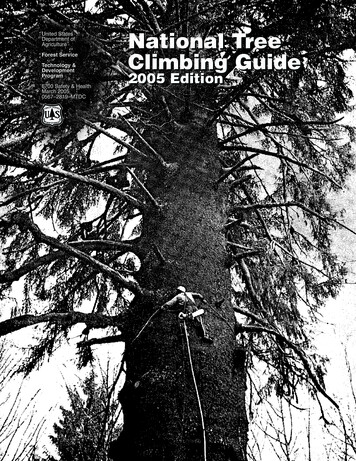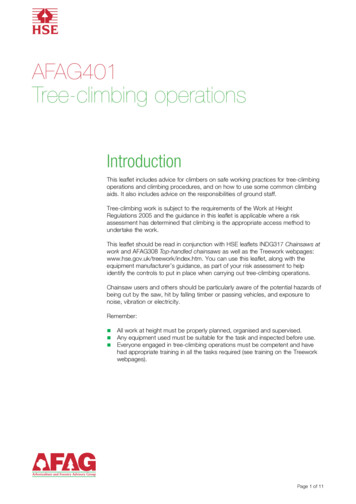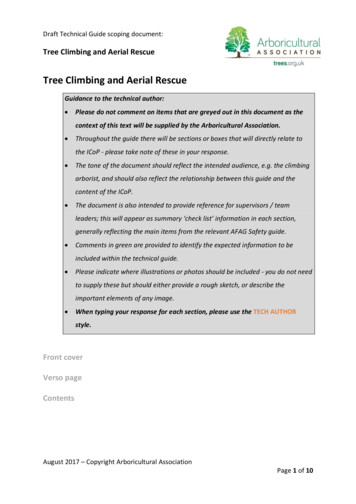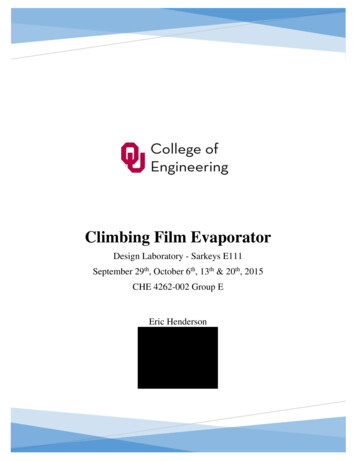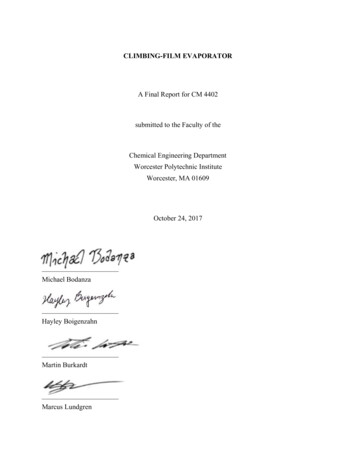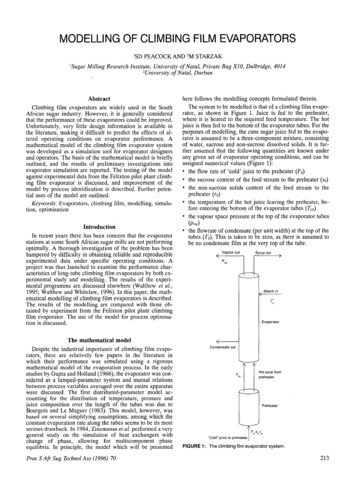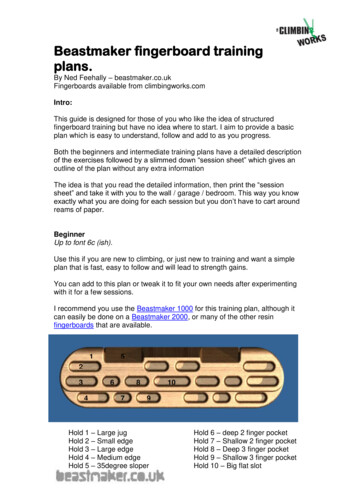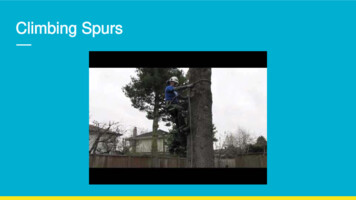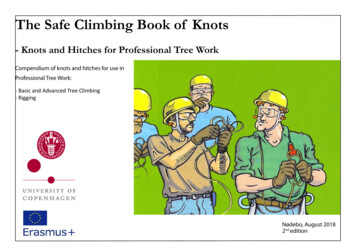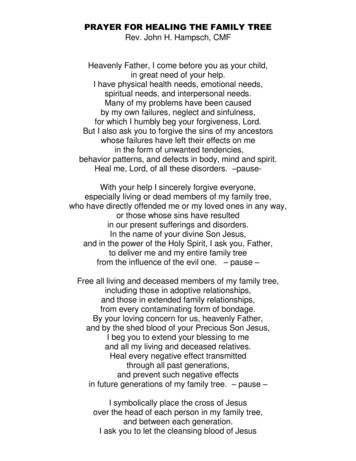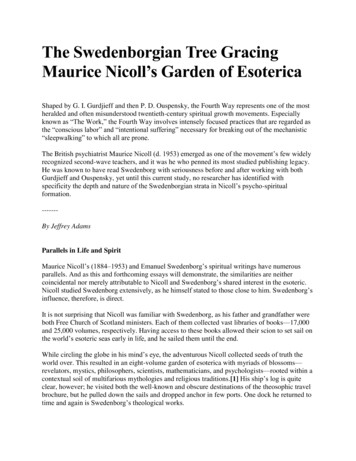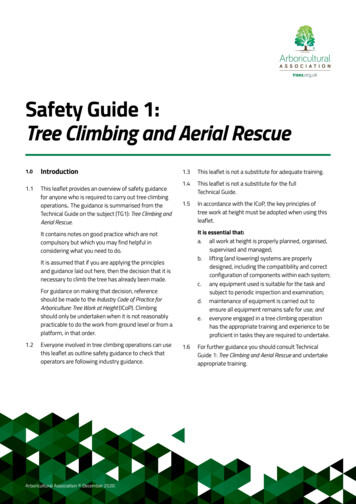
Transcription
Safety Guide 1:Tree Climbing and Aerial Rescue1.0Introduction1.1 This leaflet provides an overview of safety guidancefor anyone who is required to carry out tree climbingoperations. The guidance is summarised from theTechnical Guide on the subject (TG1): Tree Climbing andAerial Rescue. It contains notes on good practice which are notcompulsory but which you may find helpful inconsidering what you need to do. It is assumed that if you are applying the principlesand guidance laid out here, then the decision that it isnecessary to climb the tree has already been made. For guidance on making that decision, referenceshould be made to the Industry Code of Practice forArboriculture: Tree Work at Height (ICoP). Climbingshould only be undertaken when it is not reasonablypracticable to do the work from ground level or from aplatform, in that order.1.2 Everyone involved in tree climbing operations can usethis leaflet as outline safety guidance to check thatoperators are following industry guidance.Arboricultural Association December 2020.1.3 This leaflet is not a substitute for adequate training.1.4 This leaflet is not a substitute for the fullTechnical Guide.1.5 In accordance with the ICoP, the key principles oftree work at height must be adopted when using thisleaflet.It is essential that:a. all work at height is properly planned, organised,supervised and managed;b. lifting (and lowering) systems are properlydesigned, including the compatibility and correctconfiguration of components within each system;c. any equipment used is suitable for the task andsubject to periodic inspection and examination;d. maintenance of equipment is carried out toensure all equipment remains safe for use; ande. everyone engaged in a tree climbing operationhas the appropriate training and experience to beproficient in tasks they are required to undertake.1.6 For further guidance you should consult TechnicalGuide 1: Tree Climbing and Aerial Rescue and undertakeappropriate training.
Safety Guide 1: Tree Climbing and Aerial Rescue2.0Planning and ManagementRef. Checklist2.aIs tree climbing the most appropriate method for carrying out the work?2.bHas a suitable and sufficient recorded site-specific risk assessment been carried out?2.cDo operators understand the risk assessment?2.dIs there an opportunity for everyone on site to contribute to the site-specific riskassessment on the day of works?2.eAre operators fully aware of the hazards and risks they are exposed to during thespecific tree work at height task?2.fDo operators know the control measures they must implement to ensure safeworking and in turn create the safe system of work for carrying out the tree work?2.gHave the control measures specified been carried out?2.hDoes the risk assessment process include dealing with emergencies?2.iAre enough personnel present, including provision for rescue?2.jIs the weather suitable for the tasks to be carried out?2.kHas enough time been allocated to allow the work to be carried out safely and withoutapplying undue pressure on the operational team?3.02YesNoN/AYesNoN/ARoles and ResponsibilitiesRef. Checklist3.aDo all operators understand their roles and responsibilities?3.bAre operators proficient to carry out their assigned duties?3.cIs there appropriate supervision in place to manage the tree work at height operation?3.dDoes everyone on site understand the communication method between climbers andground staff? Is it clear, unambiguous and agreed by all?Arboricultural Association December 2020.
Safety Guide 1: Tree Climbing and Aerial Rescue4.0On-site PreparationRef. Checklist4.aHave hazards and risks identified by the site-specific risk assessment process beenadequately addressed?4.bHas a tree condition assessment been carried out?4.cHave clearly defined drop and working zones been established?4.dDo all operators understand the limits of each zone?4.eAre there established procedures in place (1) for when someone wants to enter adrop zone; (2) for materials to be dropped into a drop zone; and (3) when handlingequipment above the drop zone?4.fIs the extent of the work zone clear with adequate demarcation in place to preventunauthorised access?4.gIs PPE correctly worn and used by every operator in either zone?5.0YesNoN/AYesNoN/AYesNoN/AOccupational HealthRef. Checklist5.aCan everyone on site maintain ‘situational awareness’?Are they fit and well, physically and mentally?5.bIs everyone on site aware of any individual operator’s limitations?5.cDoes anyone on site require increased protection from, or reduced exposureduration to, a particular hazard which may affect their health? If so, has this beenimplemented?5.dDo the techniques selected for use minimise the risk of muscular-skeletal disordersand fatigue? Has equipment been chosen to meet the operator’s ergonomicrequirements?6.03Personal Fall Protection Systems in Tree WorkRef. Checklist6.aHas the climber elected to use a system that allows them to ascend, move around thetree and descend appropriately?6.bDoes the system correctly comprise a primary system and backup, and does thebackup provide protection against failure of the primary system, including main line,components and anchor?6.cAre the correct connection points to the harness being used, appropriate to theoperation?6.dHave all the working considerations for using a personal fall protection system beentaken into account by the climber?Arboricultural Association December 2020.
Safety Guide 1: Tree Climbing and Aerial Rescue7.0A Strategy for AccessRef. Checklist7.aDo the methods selected take into account: the tree condition assessment, climbers’abilities, training, surrounding features and tree structure?7.bHave all aspects of the chosen access method and ascent technique been discussedand agreed as a safe method of working by the team?7.cIs the work team familiar with the techniques to be used to allow an effective rescueto take place?8.0YesNoN/AYesNoN/AYesNoN/ASelecting an Ascent TechniqueRef. Checklist8.aDoes the system correctly comprise primary and backup systems?8.bDoes the climber have the appropriate knowledge to safely ascend and descend ontheir chosen system?8.cWhen an ascent technique is used, are the distance and consequences of a fallminimised?8.dDoes the climber use correct rope advance procedures during changeovers?8.eIs the climber correctly anchored to the tree at all times?8.fAre newly established anchors subjected to a full-body-weight test where practical?8.gIf spikes are used, is it possible to descend without solely having to spike back downthe stem?9.04Managing Slack and Improving Climber PositioningRef. Checklist9.aDoes the climber always remain anchored to the tree structure?9.bDoes the climber ensure that the fall protection system does not allow a potential falldistance to exceed 500mm?9.cAre two high anchors used wherever practical?9.dHas the climber included an adjustable lanyard as part of their system?9.eDoes the climber use their fall protection system appropriately to reduce the risk ofpendulum swing?Arboricultural Association December 2020.
Safety Guide 1: Tree Climbing and Aerial Rescue10.0DescentRef. Checklist10.aDoes the climber’s primary system allow for an uninterrupted descent to the ground?10.bDoes the climber check the length of rope before descent?10.cAre the climber’s systems appropriately terminated?10.dIs descent carried out in a controlled manner that minimises risk to the climber andpotential equipment damage?10.eAre anchor devices lowered in a controlled manner?11.011.aHave operators been trained in anchor point selection?11.bCan the selected anchor support any foreseeable loading?11.cHave anchors been fully load-tested prior to ascent?11.dHave load-bearing anchors within the tree been subjected to full-body-weight tests?11.eAre climbers using equipment to create anchors in accordance with themanufacturer’s guidance and is it suitable for its intended : GeneralRef. Checklist12.aIs the equipment provided suited to the task?12.bDoes everyone on site have the correct PPE and is it in good condition?13.0YesAnchors and Anchor Point SelectionRef. Checklist12.05Equipment Components: Building a SystemRef. Checklist13.aDoes the selected climbing equipment meet the relevant conformity standard?13.bAre all parts of the climber’s system correctly configured, in accordance withmanufacturer’s guidance?13.cAre neighbouring components of the system compatible with each other?13.dAre the standard(s) against which the equipment has been tested identifiable?Arboricultural Association December 2020.
Safety Guide 1: Tree Climbing and Aerial Rescue14.0Equipment for Tree Access and RescueRef. Checklist14.aAre the components of the fall protection system being used correctly in accordancewith manufacturer’s guidance?14.bDo the components selected meet technical guidance : Inspection, Care, Storage and MaintenanceRef. Checklist15.aHave operators received training in climbing equipment inspection, maintenance andrecord-keeping?15.bDo specific users of equipment understand manufacturer’s recommendations forproduct lifespan, maintenance and storage?15.cAre adequate records maintained of equipment issue, inspection, withdrawal anddisposal?15.dAre visual and tactile pre-use checks carried out to a proficient standard?16.06Aerial RescueRef. Checklist16.aHas an adequate rescue plan been prepared for aerial rescue?16.bAre suitable and sufficient resources to make an effective rescue immediatelyavailable?16.cHas the nominated rescuer(s) received training in rescue techniques and theequipment to be used?16.dDoes everyone understand their role and responsibility in the event of an aerialrescue?16.eHave the nominated rescuer and the operatives involved practised rescue techniquesat regular intervals to maintain skills?16.fCan the casualty be removed from the tree safely without risk of injury to the rescuer?Arboricultural Association December 2020.
Safety Guide 1: Tree Climbing and Aerial Rescue7NotesDate of observations:Location:Observer’s name:Signature:Who is being observed?Comments:Actions:Reference:Actions completed date:Confirmed by:Signature:Further informationFurther readingThis safety guide is one of a series produced by theArboricultural Association (AA). There is also a wide rangeof additional safety and technical information in relation toarboriculture on the AA website: www.trees.org.ukFor safety information in relation to forestry visit the ForestIndustry Safety Accord (FISA) website: www.ukfisa.comIndustry Code of Practice for Arboriculture – Tree work atheight (second edition, May 2020)For more general information about health and safetyrelated to tree work, visit the Health and Safety Executivewebsite: www.hse.gov.uk/treework/index.htmTechnical Guide 1: Tree Climbing and Aerial RescueTechnical Guide 2: Use of Tools in the TreeTechnical Guide 3: Rigging and DismantlingTechnical Guide 4: Use of Mobile Cranes in Tree WorkTechnical Guide 5: Use of Mobile Elevating Work Platforms inTree WorkFISA 802: Emergency PlanningFISA 805: Training and CertificationArboricultural Association December 2020.
Safety Guide 1: Tree Climbing and Aerial Rescue 1.0 Introduction 1.1 This leaflet provides an overview of safety guidance for anyone who is required to carry out tree climbing operations. The guidance is summarised from the Technical Guide on the subject (TG1): Tree Climbing and Aerial Rescue. It contains notes on good practice which are not

